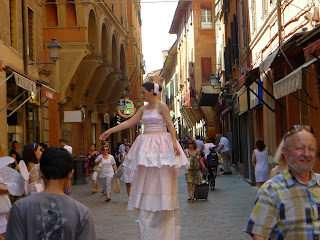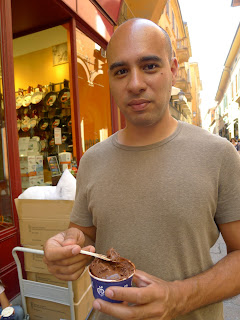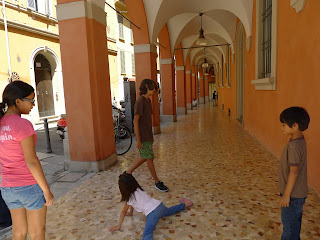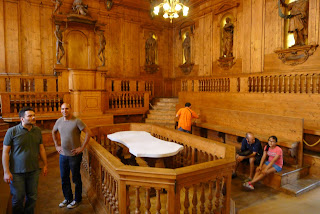By Leo Babauta
June 29, 2012
This morning the sun rose on us, in our tiny charming hotel, and lit the red, orange, yellow, ochres of Bologna, a gorgeous city nicknamed La Rossa (The Red). We had breakfast at our hotel, in a small dining room well outfitted with coffee, tea, hot chocolate, cereals, fruit, yogurt, cornetti, bread, ham, cheese, muffins, muesli ... anything our hungry stomachs might desire. It was a tiny feast fit for weary travelers, served by remarkably friendly Bolognese women.
Filled to satiety, we headed out to explore the town. It's such a pretty place, the buildings evoking images of a quiet bygone time, rustic and refined at the same time.
The streets are small and winding, the sidewalks famously covered by arching porticos to shelter walkers from the sun and rain. This is a small city built by wealthy citizens, who liked having their heads covered as they strolled about town, went to church, shopped in one of the many little boutiques that remain to this day. There are 40 miles of porticos in this city, and it's welcome in this humid heat.
We hit upon two towers standing near the center of town, each tower with a lean that threatens to flatten passersby with a strong wind. The towers were built by the wealthier aristocrats in the Middle Ages, partly as a defense against maurading invaders from the north (the Lombards, Franks, Visigoths and other such Germanic hordery) but mostly as a status symbol -- the higher your tower, the more important you must be. Strange what we humans do to impress our fellow townsmen.
Apparently building a strong foundation for your tower to prevent it from steadily leaning over wasn't part of the competition for status.
Bologna is and practically always has been a university town, with the oldest university in the western world (nearly a thousand years old), and everything is influenced by this. Most of the population isn't native to Bologna, having come to attend school, to teach, or to party with the students. Grafiti from radical students covers some of the most beautiful ancient buildings.
We wanted to climb the towers -- the tallest has 500 steps and supposedly a top-notch view of the city -- but the thick huge wooden doors seem to be locked. We later find out the towers are closed most of the time, for now, because of a recent earthquake that required repairs to many buildings.
We wander about tiny shopping streets, hitting a medieval marketplace filled with fruits, gourmet breads cheeses wines olive oil and more, fish on ice, beautiful pastas, and old people with leans as severe as the towers. It's a lovely set of cobbled streets, and we imagine buying a few choice items for a picnic (that unfortunately never materializes for lack of time).
Eva shops in a tiny department store called Coin, and we head to Bologna's central square, Piazza Maggiore, dominated by a huge basilica, an old palazzo, a library, a fountain of Neptune (Fontana di Netuna), and a massive movie screen set up for a cinema festival. The kids and I rest in shaded tables set up on the sidewalk, and sip on a cafe machiatto, juices and water (aqua naturale).
We then hit upon a great gelato shop, called Grom, and have our daily treat. The gelato is incredibly creamy, rich, delicious. We wander around the streets a bit before we meet a reader of mine, Alexander, in front of Fontana di Netuna.
Alexander turns out to be a really nice guy, German born (with a German accent when he speaks English) but now a native of Venice (Venezia) of the last 31 years. We have lunch with him in a vegetarian health food restaurant nearby called Centro Naturale, with the healthiest dishes you'll find in Italy (seitan, tempeh, vegetable pasta, veggie risoto without all the cheese, etc.).
After lunch, we walk back to Piazza Maggiore and play a game with cups and a ball that Alexander teaches us, where we meet another reader of mine, Luca. It turns out Luca is a native of Bologna, for all his 42 years, and he ends up giving us a small tour of the center of the city. Both Luca and Alexander are extremely nice, speak great English, and are vegetarians. We've lucked out.
Luca shows us the beautiful library -- really breathtaking -- that is housed in a former stock exchange hundreds of years ago. He shows us a bit of the basilica, which has a soaring interior, and some of the covered streets. We go to an ancient archive building where he takes us on a tour of a creepy room built entirely of wood, that looks like an old English courtroom, with carvings of Roman gods on the walls and ceiling. The room is actually an anatomy teaching room for medical students of yore, where autopsies (autopsia) were performed on a marble table in the center of the room as the students watched.
We tour another set of churches (actually seven churches grouped together -- Sette Chiesa) and then find a secret canal that goes through the middle of town as we head back to our hotel. We say goodbye to our new friends, Alexander and Luca.
We take our afternoon name at the hotel, and then head out for a dinner of pizza and vino rosso (of course). We don't find the pizza place we'd hoped to find, and find a little hole-in-the-wall instead -- we don't mind, as even the worst pizza is good. After, we wander around a bit and have crepes filled with nutella and cream (nutella e crema) before calling it a night and collapsing, exhaustedly, on our hotel beds. Bologna charmed us and wore us out











































No comments:
Post a Comment
Note: Only a member of this blog may post a comment.